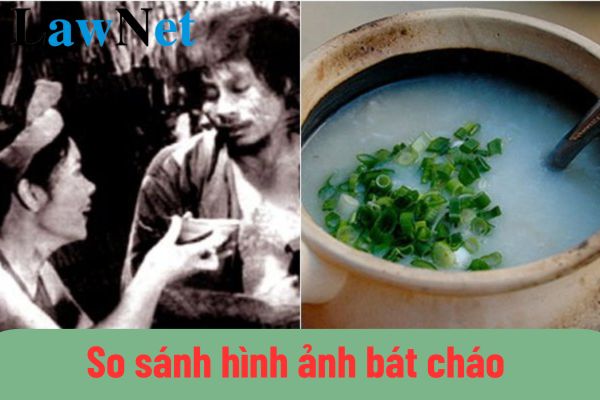Vietnam: What are the guidelines for comparison of the imagery of the bowl of onion porridge in the work "Chí Phèo" and the bran porridge in the work "Vợ nhặt"? What are the 03 academic topics in the 12th-grade Literature curriculum?
What are the guidelines for comparison of the imagery of the bowl of onion porridge in the work "Chí Phèo" and the bran porridge in the work "Vợ nhặt"?
The imagery of the bowl of onion porridge in the work "Chí Phèo" and the bran porridge in the work "Vợ nhặt", though both appearing in impoverished contexts, each carries distinct significance. The bowl of onion porridge is associated with rescue and compassion, whereas bran porridge symbolizes poverty but also represents hope and life amidst hardship. Both dishes reflect the fates and relationships within society at the time, highlighting the themes of human kindness and hope.
The comparison of the imagery of the bowl of onion porridge in the work "Chí Phèo" and the bran porridge in the work "Vợ nhặt" is practiced in the 12th-grade Literature curriculum.
Students may refer to the following sample comparison of the imagery of the bowl of onion porridge in the work "Chí Phèo" and the bran porridge in the work "Vợ nhặt":
|
Compare the Imagery of the bowl of onion porridge in the work "Chí Phèo" and the bran porridge in the work "Vợ nhặt" In Vietnamese literature, the imagery of the bowl of onion porridge in the work "Chí Phèo" and the bran porridge in the work "Vợ nhặt" are two familiar symbols, but they carry different meanings and values, reflecting circumstances, fates, and relationships within each work. |
*Note: The information is for reference only./.

What are the guidelines for comparison of the imagery of the bowl of onion porridge in the work "Chí Phèo" and the bran porridge in the work "Vợ nhặt"? What are the 03 academic topics in the 12th-grade Literature curriculum in Vietnam? (Image from Internet)
What are the 03 academic topics in the 12th-grade Literature curriculum in Vietnam?
Under Section 4 of the General Education Program for Literature issued with Circular 32/2018/TT-BGDDT, the 03 academic topics in the 12th-grade Literature curriculum in Vietnam are as follows:
Topic 12.1. RESEARCHING AND REPORT WRITING ON A MODERN AND POSTMODERN LITERARY MATTER
- Understand the requirements and methods of researching a matter.
- Know how to write a research report.
- Understand and apply some understandings from the Topic to comprehend and write about modern and postmodern literature.
- Know how to present an issue on modern and postmodern literature that they have researched.
Topic 12.2. EXPLORING A WORK OF ART ADAPTED FROM LITERATURE
- Understand what it means to adapt a literary work.
- Know how to explore, introduce, and present on a work of art adapted from literature.
- State the idea and procedure for adapting a literary work.
Topic 12.3. EXPLORING THE CREATIVE STYLE OF A LITERARY MOVEMENT: CLASSICAL, REALISM, OR ROMANTICISM
- Recognize the creative style of a literary school (movement) through some basic characteristics.
- Know the requirements and methods for exploring the creative style of a literary school.
- Know how to write an introduction about the creative style of a literary school.
- Apply understandings from the Topic to explore the creative style of other literary schools.
- Know how to present the creative style of a literary school.
What are the orientations in teaching methods for the 12th-grade Literature curriculum in Vietnam?
Under Section 6 in the Appendix to the General Education Program in Literature issued with Circular 32/2018/TT-BGDDT, the orientations in teaching methods for the 12th-grade Literature curriculum in Vietnam are as follows:
The Literature curriculum utilizes education methods oriented toward integrated and differentiated teaching; diversifying teaching methods, means, and organizational forms; promoting active, proactive, and creative learning, and applying the knowledge and skills of students.
- Based on the program, teachers proactively and flexibly build and organize lessons according to the following orientations:
+ Implement intra-disciplinary integration requirements (both knowledge and skills), interdisciplinary integration, and integrate priority education content (cross-disciplinary); implement differentiated teaching according to student subjects at all levels and differentiation contributing to career orientation in high school education.
+ Train students in methods of reading, writing, speaking, and listening; practice, experience in receiving and applying knowledge of the Vietnamese language and literature through learning activities in and out of the classroom; focus on using teaching means, overcoming the traditional reading and copying teaching style, developing thinking, training skillful use of means for students.
+ Enhance and promote student activeness and self-reliance; allocate ample time for students to study textbooks and learning materials, practice, conduct presentations, discussions, and defend learning results to enable students to read, write, speak, and listen according to varying demands and levels; assess and evaluate student task fulfillment in their learning tasks.

